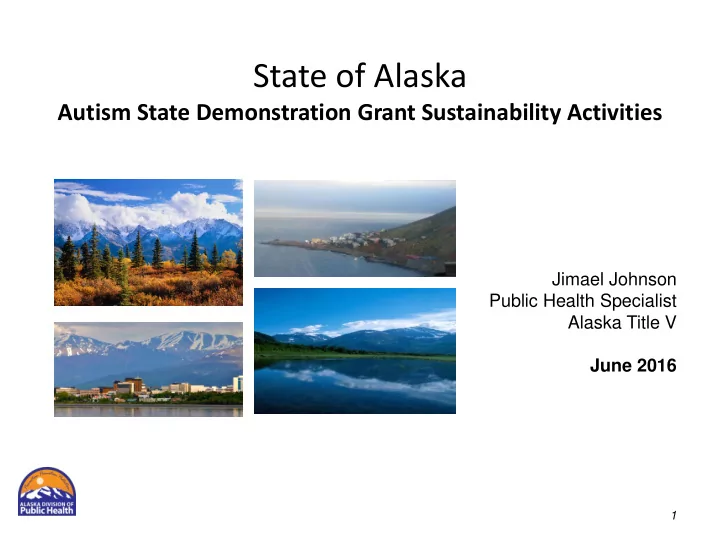

State of Alaska Autism State Demonstration Grant Sustainability Activities Jimael Johnson Public Health Specialist Alaska Title V June 2016 1
Objectives 1. History of Alaska’s Autism program and response to health inequity in rural Alaska 2. Current status of the system of care and sustainable activities 3. Future Plans for autism screening and diagnosis and workforce development 4. Lessons learned
The Governor’s Council on Disabilities and Special Education 2006 Alaska State Autism Plan Medical & Health Funding & Policy Family & Child Family Support Education & Training 1. Universal Screening 2. Diagnostic Clinic Expansion 3. Enhance Referral and Training 4. Workforce Training 5. Time Limited Intensive Autism Services 3
Combating Autism Act Initiative Alaska State Demonstration Grant (2008-2011) • Goal #1: In rural Alaska, develop new processes to support the system of developmental screening, early identification, and diagnosis for children with ASD/DD • Goal # 2: Children birth to three years old will successfully connect with early intervention services and a medical home for earlier initiation of services • Goal #3: Aligned with goals established by the Autism Alliance and ECCS to assure continuity and sustainability 4
Homer Dillingham Bethel Fairbanks Ketchikan Juneau Barrow Kotzebue Valdez Kodiak Nome Medical Providers: William Walker, MD; Beth Ellen Davis, MD Clinic Coordinator: Meghan Clark-Center for Human Development/LEND Family Navigator: Stone Soup Group 5
Did we succeed? • The average age of identification for rural kids decreased to 3-4 years. In many communities, the average is younger than 3 • While we are no longer able to visit as many communities every year, the clinic has transitioned to providing diagnostic services • Children referred to the clinic generally come with some type of prior screening 6
Sustainable Activities 7
Learn the Signs. Act Early Developmental Milestone Awareness Campaign • Family Focus Groups • Materials Localized • Direct Mailing to Families of Newborns • Radio PSA Broadcast • Part C Child Find Activity Integration 8
CYSHCN Systems Integration Grant (2014-2017) Pediatric Medical Home Program “Move the Needle” By 2017, increase the proportion of CYSHCN receiving care through a patient/family-centered medical home model approach by 20% over 2009/2010 levels of 42.8% 9
ASQ and Developmental Screening • ILP statewide initiative • ECCS alignment • EPSDT workgroup • Help Me Grow 10
• stuff • Four Core Components: Child Health Care Family & Provider Outreach Community Outreach • To support screening • To identify resources Data Collection & Centralized Monitoring Telephone Access • Including service gap Point analysis Builds collaboration across sectors to improve access Identifies gaps and barriers to access systems 11
Plans for the future • November 6, 2015 – Title V convened a one- day meeting of stakeholders to do strategic planning for the future • Included participation from in-state and out- of-state partners • Discussion on current processes and recommendations for future diagnostic service delivery 12
Updated Autism Five Year Plan 2015-2020 Priorities: 1. Screening and Diagnosis 2. Workforce Development and Training 3. Early Intervention and Educational Systems (age 0-22) 4. Integrated and Comprehensive Services 5. Funding, Billing and Systems Issues 13
Outreach Clinics • Develop a multi-disciplinary approach to the clinics • Leave complex cases to pediatric neurodevelopmental specialists • Consultation and support from a Medical Director 14
Capacity Building and Workforce Development • Leadership & Education in Neurodevelopmental & Related Disabilities (LEND) credential – Focus on rural leadership development • Board Certified Behavior Analyst (BCBA) certification – Targeted recruitment to decrease rural access inequities and use of telehealth for delivery of services • Pediatric Care Coordination training – Distance delivered university continuing ed. course with rural/cultural competence focus • On-line curriculum for primary care providers – Screening and diagnosis – Referrals to Early Intervention – Medication Management and treatment – Billing 15
Project ECHO (Extension for Community Healthcare Outcomes) • Develop a Project ECHO for Alaska related to autism and neurodevelopmental disorders • Create a provider community of practice on autism and other neurodevelopmental conditions 16
Lessons Learned • Relationships and leveraging of existing resources are key to sustainability • Specialty provider recruitment is not getting easier: we need innovative strategies to increase diagnostic and treatment capacity • Families and communities know what they need: never stop asking 17
Thank You State of Alaska Title V Section of Women’s Children and Family Health jimael.johnson@alaska.gov 907-269-7378 18
Recommend
More recommend